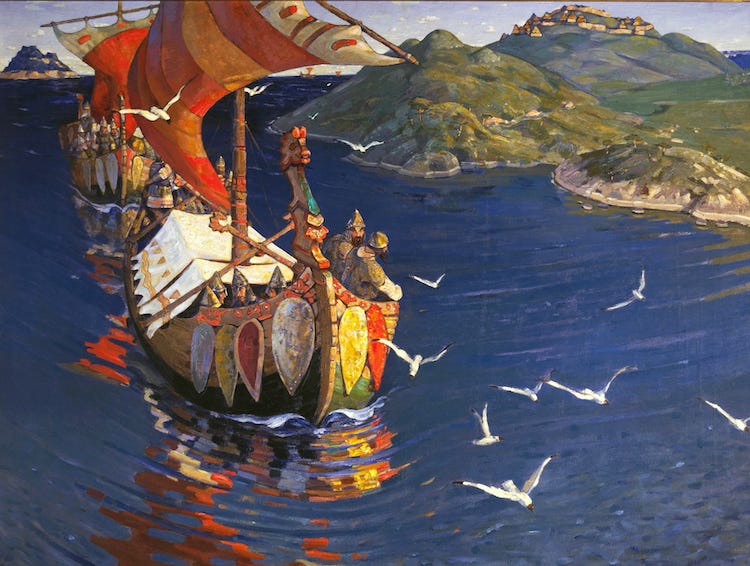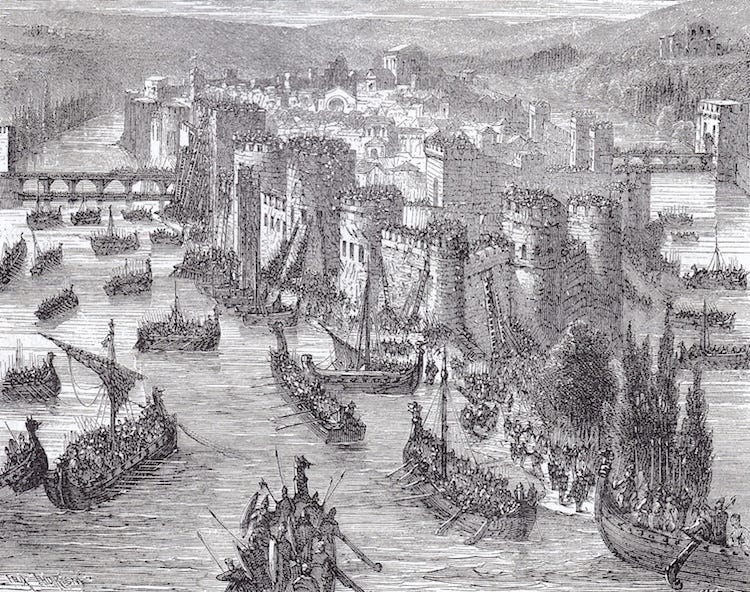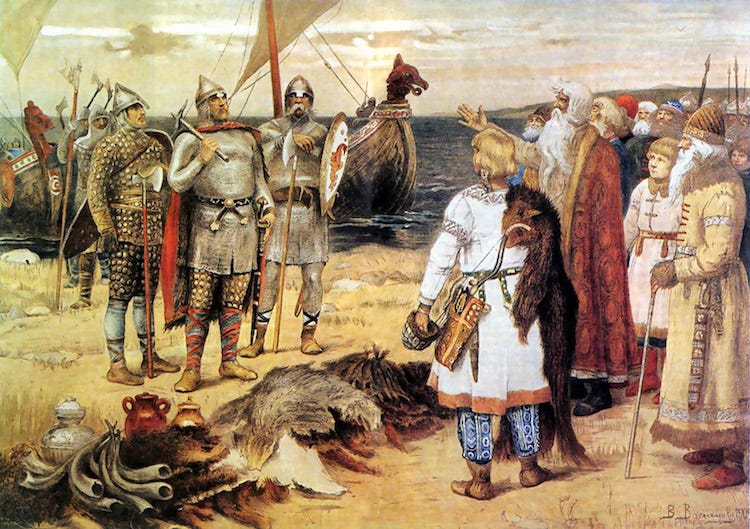What Was the Difference Between Danish, Norwegian, and Swedish Vikings?
"Simply put, the most considerable difference between Viking Age Danes, Norwegians, and Swedes is how much we know about them."
Today, we broadly refer to Viking Age Scandinavians as the Vikings as if they were one people. Linguistic nuances over the modern use of the word Viking aside, the fact is that the historical group known as the Vikings were not entirely homogenous. We know from various sources that beginning as early as the late 8th Century, large geographically related forms of identity, such as Danish, Swedish, and Norwegian, took shape (these are not to be confused with the modern notion of national identity — there were no unified forms of government that we would consider a nation-state quite yet). The Anglo-Saxon Chronicle mentions Danes and Northmen as separate; the Annals of Ulster from Ireland clearly distinguishes between the Danes and Norwegians, and in the East, the Swedes are referred to wholly separately as the Rus. If the Vikings can be broadly split into three distinct groups, the question becomes: what was the difference between the Danish, Norwegian, and Swedish Vikings?
A quick precision: the evidence suggests Viking Age Scandinavians self-identified more granularly by their specific region of origin. For example, according to the Annals of Angoulême and the Annals of St. Bertin, the Norwegian group who sacked the city of Nantes in 843 referred to themselves as Vestfaldingi, or Men of Vestfold, and not Norwegians. As we see most clearly in the history of the Yngling Dynasty in Norway, regional differences mattered, in which disparate groups in the same region make clear the differences between them. The differences between these groups would have been minor, if not imperceptible to our modern lens, but they would have been paramount to the Vikings. In parallel, there was the notion that despite their differences, the people of Viking Age Scandinavia saw themselves as a larger cultural and linguistic group that stood in contrast to the Anglo-Saxons and the Carolingians, among others, as far as we know.
Why do we think of the Vikings as one people?
The primary sources on the Vikings and their culture are an accumulation of chronicles and histories written first and foremost by religious scholars. At the time of their writing, the monotheistic religions of Christianity and Islam sought to unite the world's peoples under one god. Their convictions about their faith created a perceptual lens about the world we would call "us against them." The differences between outside groups were of little or no consequence because, ultimately, it was believed that they would eventually be converted and brought into the fold. Therefore, they created a two-dimensional view of Viking Age Scandinavians, broadly describing them all as "pagans."
An excellent example is how Muslim chroniclers framed their examinations of the Vikings within the cultural lens of Islam. The historian al-Yaqubi, in his geographical study of the Mediterranean, linked the Scandinavians from Sweden, known as the Rus, to those from Denmark who sacked Seville in Spain; he wrote that the attack on Seville, in 844 A.D. was carried out by "the Magus, who are called the Rus." His testimony denotes his understanding that they had a commonality between them but also a lack of understanding of their differences.
Fast forward to the 19th century when a renewed interest in the Viking Age began, and we see that the first scholars to approach the subject had little more than the religiously biased texts to go on. Moreover, let us not forget that the 19th century was still an age of belief, where Christian dogma was (for the most part) universally accepted in Western Europe. This allowed the same slanted view of Viking Age Scandinavians to persist for a time, which eventually led to the cultural perception that the Vikings were, in no uncertain terms, one people.
Further reinforcing the view that the Vikings were one people is that from an archaeological perspective, a distinct culture emerged at the beginning of the Viking Age that stood apart from its neighbors. Finds from Norway to Denmark and the Grobin Colony (in what is today Latvia) show a common culture shared across Scandinavia. Therefore, when we speak of the differences between the Norwegians, Swedes, and Danes of the Viking Age, we must be careful to make clear that we are dealing with three regional identities united by a more significant geographical and cultural relationship. We must also be cognizant that these differences continued to evolve throughout the Viking Age, which lasted three centuries. In 1066, the commonly employed date for the close of the Viking Age, the differences between the Danes, Norwegians, and Swedes far exceeded the differences between them in 793, the commonly employed date for the opening of the Viking Age.
What Was the Difference Between Danish, Norwegian, and Swedish Vikings?
Most of what we know about the Vikings, politically and culturally, is derived from analyses of the Danes. Chroniclers such as Dudo, Alcuin, Saxo Grammaticus, Rimbert, and Notker, among others, all focus nearly exclusively on the Danish people to form their conclusions. Therefore, we know much more about Viking Age Danes and their exploits than any other group. This is unsurprising since the Danes were far more involved with the continent's politics than the Norwegians and the Swedes.
A significant source for what we know about Viking Age Scandinavians originates from the efforts of the archbishopric of Hamburg. As early as the 820s, the cleric Anskar set out on missions into Scandinavia to convert them to his faith. He brought back some of the earliest testimony on Viking Age culture—including some rather shocking and disputed descriptions of religious rituals in what is now Sweden. Efforts to Christianise the Danes, in particular, persisted nearly the entire Viking Age, and later scholars, such as Rimbert and Thietmar of Merseburg, expanded on Anskar's work and observations. Theirs is some of the most compelling testimony of Viking Age Scandinavian culture, and archeologists have confirmed much of what they reported.
In contrast to their cousins in Norway and Sweden, the Danes consistently appear to have been a regional, cultural, and military power from the mid-8th century onward (although this could be a slant from our familiarity with the Danes). Even the Franks admitted in the Annals of Fulda that the Danes were the most powerful among the Northmen. As a political power, the Danes had the closest approximation to a formal monarchy of any of the three regions. Although they experienced political turmoil at the beginning of the 9th century, their rulers reigned consistently throughout the Viking Age, giving the Danes a political and societal strength the others appear not to have had to the same degree.
The Danes were also heavily involved in regional politics. The Royal Frankish Annals recorded that the Danes sent an emissary in 782 to Charlemagne’s court, along with other Saxon leaders, to hold formal political discussions in response to the massacre of Verden, in which the Franks captured, forcibly baptized, and murdered a reported three thousand Saxon warriors mere miles from the Danish border. Although there is no mention of what came of that meeting, it demonstrates the Danes were interwoven in the events of the time. They did not, as the chronicler Alcuin of york suggested in his letter to Higbald, appear from nowhere in 793.
While the Danes were not alone in developing ambitious plans for territorial conquest, theirs involved enemies who better chronicled their exploits. Their invasion of Britain, the establishment of the Danelaw, and the settlement of Normandy put them front-and-center in the Christian world and closer proximity to the most important intellectual centers of the day. The Swedes also expanded, but their exploits East appear in fewer texts. In fact, only one chronicle, the Russian Primary Chronicle, speaks of their early exploits. Though we have Anskar’s mission to Birka to tell us about the Rus’ cultural and religious practices, it is hard to say which of those differed from the Danes and Norwegians because we do not have comparable testimonies about them. The Norwegians were exceptionally active in Ireland and Brittany, but the sources about their activities are scarce in the form of the Annals of Ulster and other disparate documents of the day. Sagas are often evoked to argue that we know as much about the Norwegians as the Danes, but sagas are problematic. Written centuries after the fact, they incorporate numerous elements undermining their credibility as a source. Even if we could treat the sagas as authoritative, the Danes feature as widely, if not more, in them than the Norwegians and Swedes.
It is against our body of knowledge about the Danes that we tend to compare the other Vikings. Unfortunately, we do not know much about Norway and Sweden's early political formations. The Ynglingasaga, the saga of the Yngling Dynasty in Norway, purports to tell of the events that led to the establishment of Norway’s monarchy. However, it offers very little substance about the structure of their society, their influence over neighboring peoples, and the cultural backbone that drove their ambitions. We do know that the Norwegians were poised to conduct raids before their Danish cousins — they were the first to attack Ireland and Western France and are thought to have carried out the raid on Lindisfarne — but ultimately did not exert the same influence as the Danes across Europe. An example of this is the invasion of Brittany in the late 9th Century, where Norwegian Vikings took control of the regional center of Nantes. They held it for years until the Bretons expelled them, only to find a derelict city and no concerted effort to colonize the land as the Danes had done in Britain and Normandy.
Similarly, the Swedes, then known as Varangians or Rus, were poised to discover and pillage new lands in the East along the Volga and Dnieper rivers. Their expeditions, however, were of a different sort than the Danes and Norwegians in the west. The goal of the Rus was primarily to trade (or so we think). They established long trade routes to the Middle East and around the Black Sea. They avoided much more than that until the late 9th Century when, according to the Russian Primary Chronicle, the brothers Rurik, Sineus, and Truvor were “invited” by the Slavs to be their rulers. To this day, why this event occurred is unclear, but most historians believe this was a capitulation by the Slavs to years of raids. What is clear is that the entire passage that speaks of the Rus is concise, and from this moment on, the Rus who did move east to join the ruling class quickly assimilated into the Slavic culture and ceased to be what we would call “Vikings.”
The account of Ibn Fadlan during his embassy to the land of the Khazars demonstrates a few stark differences between the Rus and the Danes. For one, the Rus were allegedly covered in blue tattoos, which is not something that Western chroniclers reported. The method of burial for their king and their grooming habits, among other details, stand in contrast to the Danes, though these have been disputed as fabrications by the author. Likewise, the Frankish chronicler Rimbert recounts the mission of Anskar to Sweden to convert them to Christianity, where he describes the unusual and shocking religious rituals of the Swedes at Upsala, including human sacrifice. The fact that the Swedes may have been somewhat different from their Danish and Norwegian cousins from a cultural and spiritual standpoint is still hotly debated. Again, it is hard to say anything for sure, as the sources in question have disagreements that undermine their credibility.
The Danes: The Original Vikings?
Due to our general ignorance of the political and cultural structure of early Swedish and Norwegian society, the main difference between the three groups ultimately boils down to how much we know about them, especially early on. Archeologically speaking, the three groups were similar enough in the early 9th century to be indistinguishable, sharing a distinct common culture, as evidenced by ship burials and colonies in all three regions, which stood apart from their neighbors (i.e., Saxons, Slavs, Obrodites, Finns, Lapps, and others). By that account, the Danes, as evidenced by the texts we have about them, are far and above the most familiar to us and tend to drive our conception of what it was to be a Viking. From there, we can say that the Norwegians participated in Ireland and France and made the great leap across the pond to Iceland, Greenland, and the Americas. However, culturally and politically, much of what we think we know about them appears to be derived from our familiarity with the Danes, and, as discussed above, our modern propensity to lump all Viking Age Scandinavians into the same group further exacerbates that trend. Likewise, much of what we think we know about the Swedes appears to derive from our familiarity with the Danes. However, we do have evidence to suggest the Rus were considerably different from the Danes and Norwegians. Simply put, the most considerable difference between Viking Age Danes, Norwegians, and Swedes is how much we know about them.






Great post, CJ. Love the choice of illustrations too!